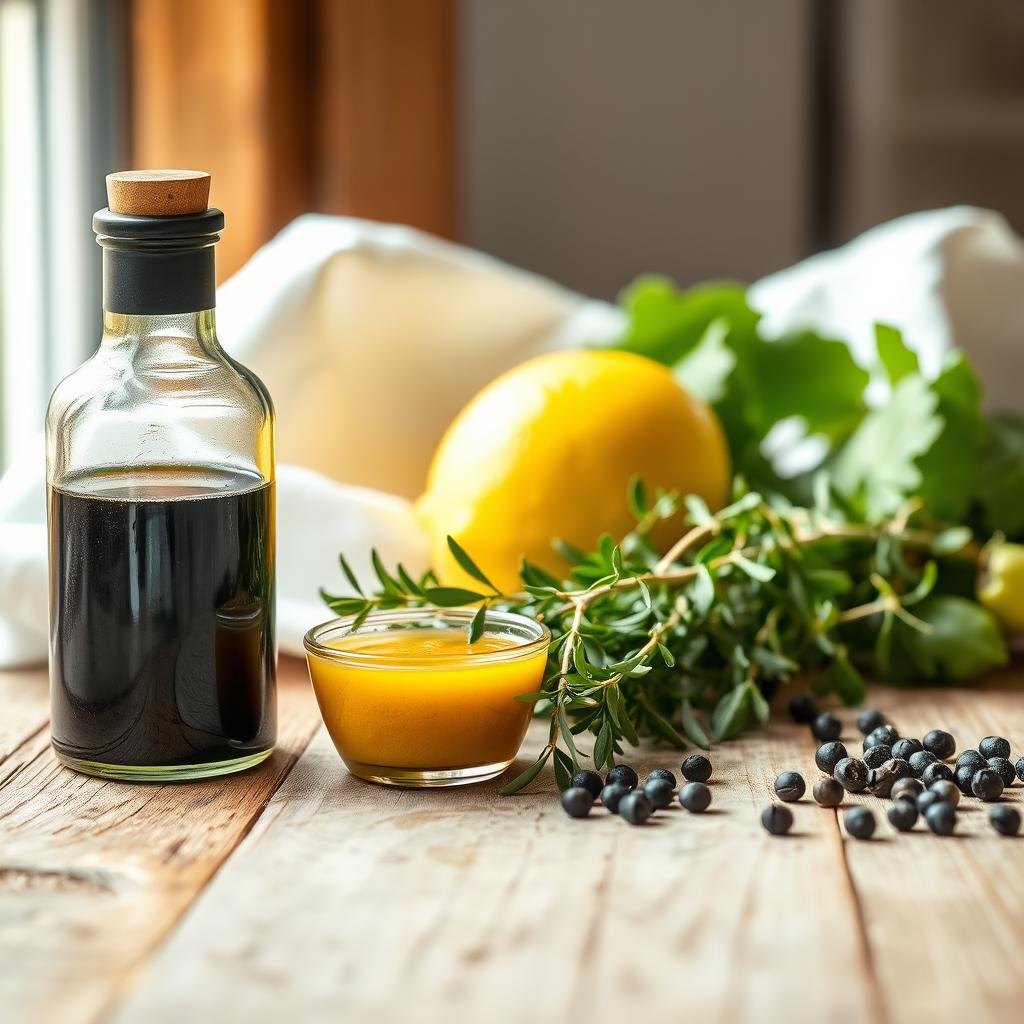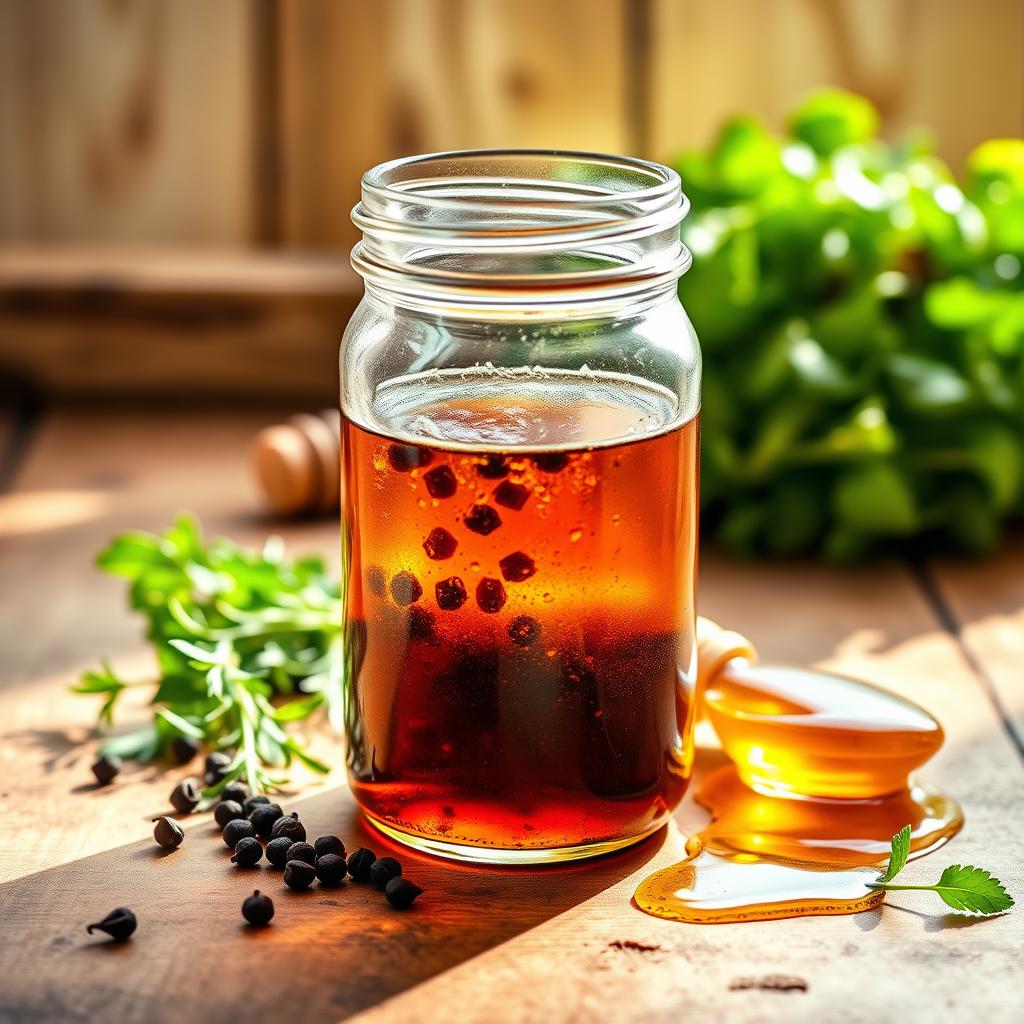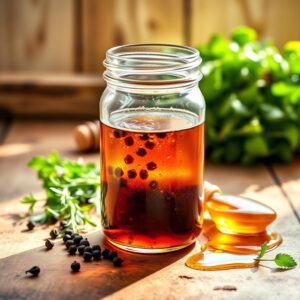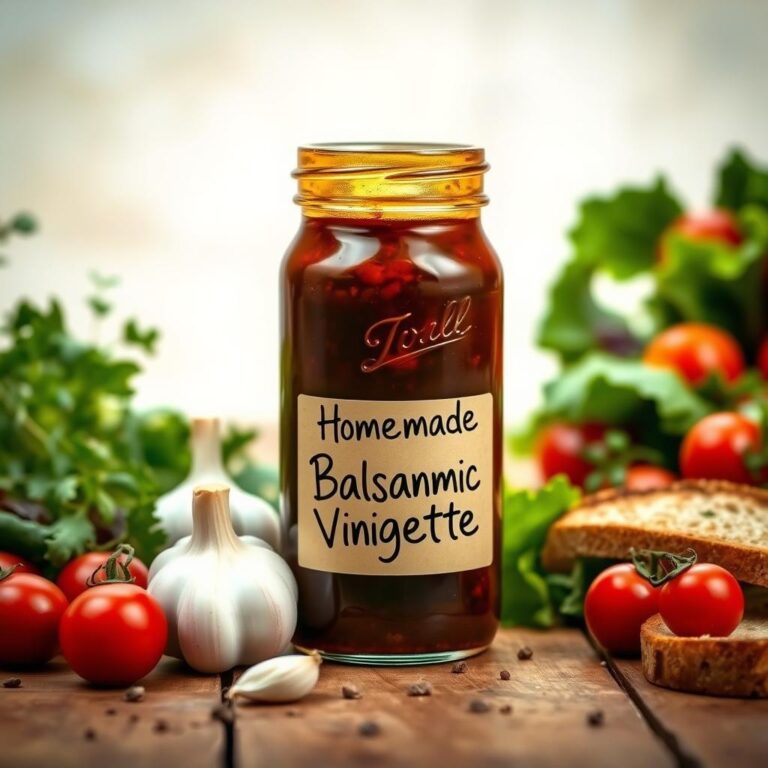Ever since I started making my own dressings, salads have never been the same. What began as a simple experiment years ago turned into a go-to blend I use weekly.
Today, I’m sharing my favorite creation healthy balsamic vinaigrette recipe—a tangy, balanced mixture that’s ready in minutes and costs far less than bottled versions.
I’ve perfected this blend over the years, tweaking ratios until it became just right. All you need are six pantry staples: olive oil, vinegar, honey, garlic, mustard, and a pinch of salt. Combine them in a jar, shake vigorously, and voilà—you’ve got a dressing that works on greens, roasted vegetables, or grilled proteins.
What makes this version stand out? Quality ingredients matter. A rich, aged vinegar adds depth, while extra virgin olive oil creates a smooth finish. Trust me, it’s worth splurging on these two items—they’re the backbone of the flavor.
If you enjoy creative salads, you might even try my Chicken Salad Recipe No Celery for an extra burst of freshness.
Key Takeaways
- Ready in 5 minutes with no special equipment required
- Uses six simple, affordable ingredients you likely already own
- Works as a marinade, drizzle, or dip beyond just salads
- Saves money compared to store-bought options
- Easily adjustable to match personal taste preferences
A Fresh Take on Homemade Salad Dressing
I used to dread boring salads until a friend showed me how a homemade blend can change everything. My kitchen experiments taught me one truth: store-bought versions can’t match the vibrancy of fresh, customizable mixes. That’s why I developed a formula that balances sharpness and sweetness—without relying on stabilizers or hidden sugars.

What Makes My Recipe Unique
Most dressings either overpower greens or vanish into the background. Mine hits the perfect middle ground. The trick? A 3:1 oil-to-vinegar ratio boosted by a spoonful of dijon mustard. This golden emulsifier binds everything while adding a peppery kick that complements fruity Vinegar balsamic notes.
I also skip the sugar. Instead, a drizzle of raw honey softens the acidity naturally. You’ll taste each layer—garlic’s warmth, olive oil’s grassiness, and that signature tang—without any single element dominating.
The Benefits of Making Your Own Dressing
Store shelves overflow with options, but none let you control what’s inside. My mix uses six real ingredients you can pronounce. No xanthan gum. No potassium sorbate. Just pure flavors that make even simple butter lettuce taste exciting.
Cost matters too. A quality bottle costs $5–$7, but my version runs under $2 per batch. Plus, you can tweak it endlessly—add herbs, swap citrus, or dial up the garlic. Once you try homemade, those factory-made bottles lose their appeal fast.
My Journey with Homemade Salad Dressings
It all started when I flipped a store-bought bottle and stared at ingredients I couldn’t pronounce. That moment sparked my shift to crafting blends where every component has purpose. What began as skepticism became a flavorful rebellion against preservatives and blandness.

Why I Ditched the Bottle
Pre-made options often hide stabilizers and excessive sugars. I wanted freshness I could control—no more chemical aftertaste or wasted money. My first experiments used basic pantry items, but the real breakthrough came when I discovered aged vinegar’s depth and fresh garlic’s punch.
Crafting My Signature Blend
Early versions were either too sharp or flat. Through months of tweaking, I landed on a formula that sings. The magic happens when:
- Robust vinegar meets smooth olive oil in a 3:1 ratio
- Fresh garlic gets finely minced (never powdered)
- Everything gets shaken in a glass jar for perfect emulsion
| Factor | Store-Bought | My Version |
|---|---|---|
| Ingredients | 12-15 items | 6 simple elements |
| Cost per batch | $5-7 | Under $2 |
| Flavor Control | Fixed profile | Adjustable daily |
Now, I make small batches weekly. Swapping honey for maple syrup or adding herbs keeps it exciting. This evolution taught me that great dressings aren’t found—they’re crafted.
Healthy Balsamic Vinaigrette Recipe: My Favorite Homemade Dressing
The secret to a memorable dressing lies in the harmony of its components. After testing countless ratios, I discovered precision with timing and proportions transforms ordinary mixes into something extraordinary. Let’s break down what elevates this blend from good to can’t-stop-drizzling status.
Key Ingredients That Make It Stand Out
Start with ½ cup of extra virgin olive oil—its fruity notes form the base. Pair it with ½ cup aged vinegar for depth. Add 1 minced garlic clove, 1 tsp dijon, 1 tbsp honey, and ¼ tsp salt. These six elements create a symphony when balanced right.
Timing matters most. Combine everything in a mason jar and shake exactly 45 seconds. This isn’t arbitrary—it’s the sweet spot where oil and acid emulsify into silky perfection. Stop too soon, and it separates. Shake too long, and flavors muddle.
Premium olive oil isn’t optional. Cheap versions taste flat or bitter. Splurge on a bottle labeled “cold-pressed”—its grassy aroma elevates every bite. Salt also plays a stealth role: a pinch brightens acidity, while excess drowns subtlety.
Whisking works if you’re patient, but shaking delivers consistent results in minutes. I make it fresh weekly—the garlic mellows over days, creating new layers. Adjust honey for sweetness or add herbs, but master this base first. Once you nail these ratios, you’ll never settle for less.
Essential Ingredients for a Tangy and Balanced Vinaigrette
The difference between a good dressing and a great one comes down to your ingredient choices. While basic versions work, premium components create layers of flavor that turn simple greens into something memorable. Let’s explore the stars of this show.
Selecting Quality Balsamic Vinegar
Not all vinegars are created equal. Aged varieties develop complex caramel notes that cheap imitations can’t match. Look for labels stating “aceto balsamico tradizionale”—these undergo years of barrel aging for depth. A tablespoon of the good stuff adds sweetness without sugar, balancing bitter greens beautifully.
The Role of Extra Virgin Olive Oil in Your Dressing
This oil isn’t just a base—it’s the backbone. Cold-pressed options retain peppery undertones that elevate every bite. Avoid anything labeled “light” or “pure.” Instead, choose bottles with harvest dates and a vibrant green hue. Pair it with your vinegar in a 3:1 ratio for that signature silky texture.
Here’s why ingredient quality matters:
- Superior vinegar clings to leaves instead of pooling
- Robust oils carry flavors evenly across salads
- Fresh garlic and dijon create emulsion without additives
| Ingredient | Standard | Premium |
|---|---|---|
| Vinegar | Sharp, one-note | Layered, sweet-tart |
| Oil | Neutral flavor | Grassy, aromatic |
| Sweetener | Refined sugar | Raw honey |
Always use a tight-sealing lid for storage—oxygen dulls flavors fast. Measure ingredients precisely (I swear by my ½ cup for oil) and shake vigorously. These small steps make all the difference in your weekly meal prep.
Step-by-Step: How I Create the Perfect Vinaigrette
Creating the perfect blend isn’t magic—it’s method. Let me walk you through my process. Whether you’re a kitchen newbie or a seasoned cook, these techniques ensure a smooth, flavorful result every time.
Blending vs. Shaking: My Methods Explained
I use two approaches depending on my tools and time. For quick batches, I grab a mason jar with a tight lid. Add ½ cup extra virgin olive oil, ¼ cup vinegar, and remaining ingredients. Shake hard for 45 seconds—the golden rule for proper emulsification.
When I want ultra-smooth texture, I blend. This works best with fresh herbs or garlic. Pulse 3-4 times, then drizzle oil slowly. Blending creates a creamier consistency but requires cleanup. Shaking wins for speed and simplicity.
Perfect Emulsion Techniques
Emulsion separates good dressings from great ones. Here’s my foolproof system:
- Always start with room-temperature ingredients
- Add dry elements first (garlic, mustard), then liquids
- Shake in upward motions to trap air bubbles
Timing is critical. Stop shaking when the mix turns slightly opaque—that’s your cue it’s bonded. If it breaks, add ½ tsp honey and shake again. The natural sugars act as a binder.
| Method | Best For | Time Needed |
|---|---|---|
| Shaking | Quick prep, minimal cleanup | 1 minute |
| Blending | Creamy textures, herb infusion | 5 minutes |
Store your mix in the fridge, but let it sit at room temp before using. Cold virgin olive oil solidifies—a quick warm-up restores its silky flow. Taste and adjust: a pinch of salt or squeeze of lemon can revive flavors after storage.
Versatile Ways to Use This Vibrant Balsamic Dressing
This blend became my kitchen’s MVP once I realized its full potential. Beyond greens, it transforms proteins, grains, and even fruits into showstoppers. Let’s explore how to maximize its impact across meals.
Salad Ideas and Beyond
My go-to move? Tossing it with a spinach salad loaded with strawberries and goat cheese. The tangy-sweet notes cut through creamy textures perfectly. For something savory, try drizzling it over a Caprese stack—ripe tomatoes, fresh basil, and mozzarella sing with just a teaspoon.
Don’t stop there. Toss roasted beets in it before serving, or brush it onto grilled portobello mushrooms. I’ve even used it as a dip for crusty bread by mixing in a spoonful of Greek yogurt. The possibilities stretch as far as your pantry does.
Enhancing Roasted Veggies and More
Roasted carrots? Drizzle this blend post-oven for a glossy finish. Marinate chicken thighs overnight with ¼ cup dressing plus a dash of smoked paprika. The acidity tenderizes meat while building layers of flavor you can’t get from store-bought dressings.
Sweet applications work too. Swap honey for maple syrup in the mix, then toss with roasted apples or pears. A light coating adds brightness without overpowering natural sugars. Keep a jar handy—you’ll find excuses to use it daily.

Healthy Balsamic Vinaigrette
Equipment
- Mason jar with lid
- Measuring Cups
- Measuring spoons
- Knife
- Cutting Board
Ingredients
Ingredients
- 1/2 cup extra virgin olive oil cold-pressed preferred
- 1/4 cup aged balsamic vinegar or any high-quality balsamic vinegar
- 1 clove garlic minced
- 1 tsp Dijon mustard
- 1 tbsp raw honey or substitute with maple syrup
- 1/4 tsp salt adjust to taste
Instructions
- Step 1: Add the minced garlic, Dijon mustard, raw honey, and salt to a mason jar.
- Step 2: Pour in the aged balsamic vinegar and extra virgin olive oil.
- Step 3: Seal the jar tightly and shake vigorously for 45 seconds, or until the mixture is fully emulsified and slightly opaque.
- Step 4: Taste and adjust seasoning if needed. Use immediately or store in the fridge.
Notes
Nutrition
Conclusion
What began as a quest for better flavor became a kitchen staple I reach for daily. Using virgin olive oil and aged vinegar creates depth no store-bought bottle can match. This mix shines on everything from peppery spinach salads to roasted veggies—it’s the multitasker my fridge always needs.
Store your batch in the fridge, but don’t panic if the oil solidifies. Let it sit at room temp, then give it a quick stir by hand or in a bowl. Swap honey for maple if you prefer earthy sweetness, or add cracked pepper for extra zing.
I’d love to hear how you make it yours! Share your twists below—every kitchen deserves this vibrant upgrade. Now grab that jar, and let those fresh flavors dance.
FAQ
Can I use regular olive oil instead of extra virgin?
I always use extra virgin olive oil for its rich flavor, but regular works in a pinch. Just note the taste will be milder.
How long does homemade dressing last in the fridge?
Mine stays fresh for 7-10 days when stored in a sealed jar. Give it a good shake before each use!
What’s the best way to balance tanginess?
Start with a 3:1 oil-to-vinegar ratio. If it’s too sharp, add a touch of honey or maple syrup to mellow it out.
Can I substitute Dijon mustard?
Absolutely! I love Dijon for its zing, but yellow mustard works too. Avoid coarse-grained varieties for smoother texture.
Is this dressing good on warm dishes?
Yes! I drizzle it over roasted veggies or grilled chicken. The acidity brightens up warm meals beautifully.
Why does my vinaigrette separate quickly?
Emulsifying with mustard helps bind ingredients. If it separates, just shake or whisk again—it’ll come right back together.
Can I add fresh herbs to the mix?
Go for it! Basil, thyme, or rosemary add lovely depth. I add them sparingly to avoid overpowering the base flavors.
